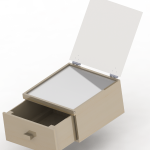
This is work-in-progress; I am looking at various power generation technologies that can be used in Zimbabwe and the rest of Africa sustainability. In the spring of 2012, I teamed up with friends and colleagues in the US and in Zimbabwe to do a preliminary research on the use of wind turbines in the Dumbamwe area in Rusape, Zimbabwe.
In fall 2014 I picked-up the solar cooker part of the project; I am modeling the heat transfer in a solar box-type cooker in a bid to investigate the effect of using commercially available materials on solar box-type designs.

Seven turbines were installed at Dumbamwe Secondary School in 2000 by ZERO Regional Organization. These turbines had been manufactured by Africa Wind Power, then called PowerVision. At the time of their installation, the turbines benefited local businesses in Dumbamwe. However, at the time that my team arrived, in March 2012, the turbines were no longer working (see picture). [1]
As a wind turbine enthusiast, I think that the use of wind turbines in Zimbabwe should be re-visited. Although most areas in Zimbabwe have low average wind speeds (about 4m/s) [2],
some areas in the Eastern Highlands have good wind speeds that are ideal for power-generating wind turbines. Nevertheless, water pumping wind turbines can be utilized in other areas. Pursuing the same vision, I designed a prototype wind turbine while in college. Here is the small-scale turbine.

The idea of solar cookers is most relevant to most areas of Zimbabwe. Zimbabwe receives insolation of about 825 W/m2 [3] and the solar cooker technology is inexpensive and simple. Solar
cookers can be easily manufactured in Zimbabwe using local talent and materials.
In the future , I plan to design a functional low-cost turbine and solar cooker.
References
[1] G. Watson(1999). Wind Turbine Charger For Africa. Engineering Village
[2] G. Lewis (1985). The Availability of Wind Power In Zimbabwe. Engineering Village
[3] R. Mukaro, D. Tinarwo (2008). Performance evaluation of a hot-box reflector solar cooker using a microcontroller-based measurement system. International Journal of Energy Research. Engineering Village

- Ikhupuleng Dube (2003). Impact of energy subsidies on energy consumption and supply in Zimbabwe. Do the urban poor really benefit?
- Southern Center for Energy and Environment (2001). Implementation of Renewables Energy Technologies – Opportunities and Barriers (Zimbabwe Country Study)
- B Batidzirai, et al (2009). Potential for solar water heating in Zimbabwe
- A Zimbabwean man develops a functional wind turbine from scrap metal/parts (2012). Read more
- Davidson, Ogunlade, and Stanford Mwakasonda. “ScienceDirect – Energy for Sustainable Development : Electricity Access for the Poor: a Study of South Africa and Zimbabwe.” ScienceDirect – Home. Energy for Sustainable Development, Dec. 2004. Web. 24 Feb. 2011.
- Mungwena, W.1 Source: Renewable Energy, v 26, n 3, 363-77, July 2002; ISSN: 0960-1481; DOI: 10.1016/S0960-1481(01)00141-0; Publisher: Elsevier, UK
- Watson, G.; Maboyi, B.; Matirekwe, D.; Piggott, H.; Smyth, O.; Murgatroyd, N. Source: Renewable Energy, v 16, n 1-4, 934-9, Jan.-April 1999; ISSN: 0960-1481; DOI: 10.1016/S0960-1481(98)00326-7; Conference: Renewable Energy. Energy Efficiency, Policy and the Environment. World Renewable Energy Congress V, 20-25 Sept. 1998, Florence, Italy; Publisher: Elsevier, UK
- Green Step is an organization that helps communities make low-cost wind turbines. Read more.
Below is an excerpt from www.scoraigwind.com
Temaruru is a site in the eastern highlands where Powertronics of Harare has installed a stand alone community wind power station. There are four machines. Each has 3.6m diameter and nominal 1kW power rating.
This wind turbine is the commercial version of the ZERO project in 1996 or, more recently, the Powertronics 3600. Manx Wind Energy had me design it. I also use one to power my home in Scotland. A new company African Windpower has been set up to manufacture the machines…..
Power is stored at 48 volts DC in a 400 amphour battery, at the power centre, and converted to 220 volt AC using Powervision 3kW sine wave inverters. Powervision is a joint venture of Powertronics and Innovision (of Denmark).
Future developments will include installation of solar modules to supplement the wind turbines, and maintain the supply in calm weather. A battery charging facility will be offered at the power centre, along with low energy lights, solar modules and other electrical supplies.
Powertronics, the parent company is a power electronics manufacturing company in Harare. African Windpower is starting operations in an adjacent unit.

